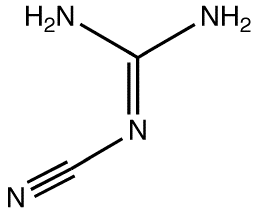 2-Cyanoguanidine, also known as DCD (dicyandiamide) is a nitrile derived from guanidine used as a curative agent for epoxy resins in packaging.
2-Cyanoguanidine, also known as DCD (dicyandiamide) is a nitrile derived from guanidine used as a curative agent for epoxy resins in packaging.
Since 2004, it has been used in New Zealand by farmers hoping to lower the environmental impact of livestock by reducing the rate at which soil microbes convert ammonia from animal urine into nitrates and nitrous oxide, thus slowing nitrate leaching from pasture.
DCD recently hit the headlines when traces were found in milk. Although the authorities said of the Westland Milk Products example that it did not represent a health risk to consumers, there are echoes of the melamine debacle I first discussed on Sciencebase back in September 2008; manufacturers have withdrawn DCD products from the agricultural market.
Direct exposure to DCD powder may cause irritation to the eyes, skin, and respiratory tract. However, toxicity level is rather low, certainly well below trace levels found in milk products. ‘Experiments with mice indicate that the lethal dose (LD50) for table salt (sodium chloride) is 4 grams per kilogram of body weight. For DCD it is more than 2.5 times that at over 10 grams per kilogram.